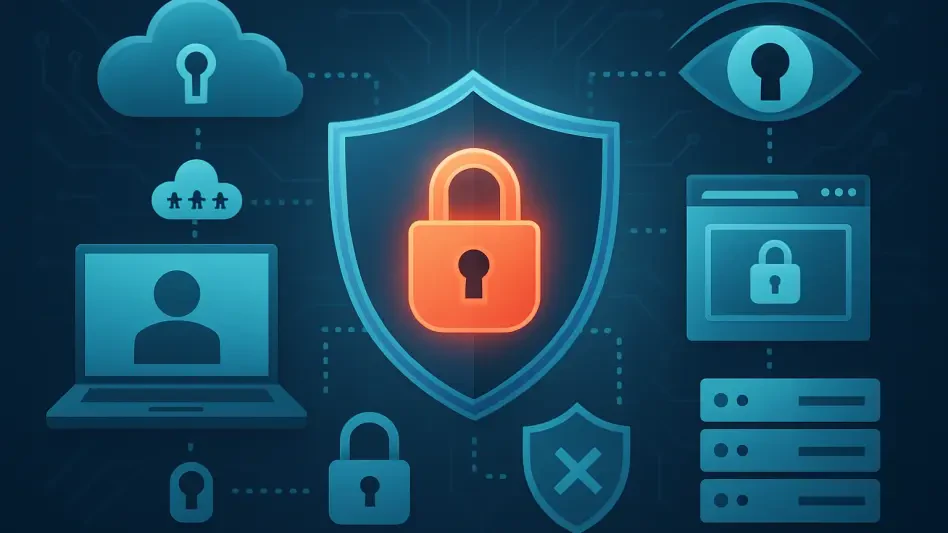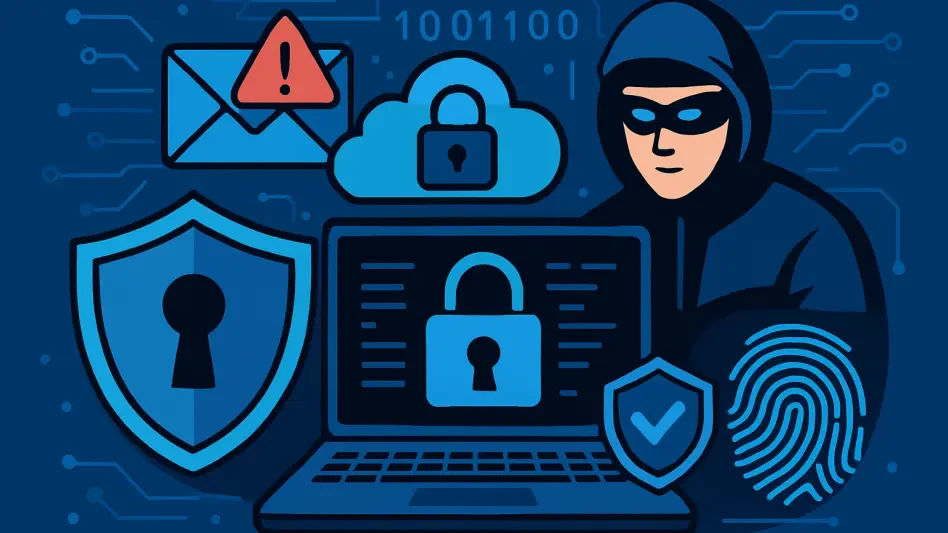In an era where cyber threats morph and multiply with staggering speed, the once-reliable security models that guarded organizational networks are crumbling under pressure. The explosion of cloud computing, the normalization of remote work, and the widespread use of personal devices have obliterated the concept of a defined network perimeter, exposing businesses to increasingly cunning attacks. Zero Trust Network Access (ZTNA) emerges as a revolutionary framework, rooted in the mantra of “never trust, always verify,” offering a stark contrast to outdated systems that presumed safety within network boundaries. This approach meticulously scrutinizes every access request, regardless of its origin, ensuring that no assumption of trust leaves a door ajar for potential breaches. As companies grapple with hybrid work setups and cloud-first strategies, ZTNA stands as a beacon of resilience, shifting the security focus from physical perimeters to the identities of users and devices. This transformation isn’t merely a passing fad but a critical adaptation to a digital landscape where threats lurk both inside and outside traditional walls.
Understanding Zero Trust Network Access
Core Principles and Mechanisms
Zero Trust Network Access represents a seismic shift in cybersecurity, directly addressing the vulnerabilities exposed by modern digital environments and highlighting the inadequacies of outdated security models. Traditional perimeter-based security, which relied heavily on firewalls and VPNs to create a supposedly safe internal zone, has become obsolete as network boundaries dissolve with cloud adoption and remote access. ZTNA flips this model on its head by assuming no inherent trust, whether a user or device operates from within an office or halfway across the globe. Every single interaction must pass through stringent authentication and authorization checks, ensuring that access is granted only to verified entities. This principle of continuous scrutiny forms the bedrock of ZTNA, providing a proactive shield against sophisticated threats that exploit assumed trust. By prioritizing verification over location, this framework aligns seamlessly with the dynamic, borderless nature of today’s business operations, safeguarding assets in an unpredictable threat landscape.
At the heart of ZTNA lies an identity-centric approach, setting it apart from older systems like VPNs that often grant broad network access after a single login. This model relies on robust mechanisms such as multi-factor authentication (MFA) and integration with identity providers to confirm user legitimacy before any resource is unlocked. Beyond initial verification, ZTNA enforces continuous monitoring, adapting access privileges in real time based on behavioral anomalies or device status changes. This relentless evaluation minimizes risks by ensuring that even a compromised account cannot cause widespread damage across an entire network. Additionally, ZTNA champions the concept of least-privilege access, restricting users to only the specific tools or data essential for their roles. Such granular control sharply contrasts with VPNs, which can expose vast network segments to potential lateral movement by attackers, making ZTNA a far more precise and secure solution for contemporary challenges.
Comparing Traditional Models to Modern Solutions
While VPNs have long been a staple for remote connectivity, their design inherently clashes with the demands of today’s threat environment, which requires more granular security measures to combat evolving risks. These tools typically authenticate a user once and then provide unfettered access to large swaths of a network, creating opportunities for attackers to move laterally if credentials are stolen. ZTNA, on the other hand, narrows the scope dramatically by tying access to individual applications rather than entire systems. This application-level segmentation curtails the potential “blast radius” of a breach, ensuring that even a successful intrusion remains contained. By eliminating the broad trust zones that VPNs establish, ZTNA better protects sensitive data and critical infrastructure, aligning with the reality of distributed workforces where employees connect from diverse, often unsecured locations.
Moreover, ZTNA offers scalability that traditional VPN setups struggle to match in the face of expanding digital footprints. As organizations adopt cloud services and support remote teams, VPNs often introduce latency and complexity, bogging down performance with every additional user or endpoint. ZTNA circumvents these pitfalls by leveraging cloud-native architectures to deliver direct, secure access to applications without routing traffic through cumbersome central gateways. This streamlined process not only enhances speed but also reduces the burden on IT teams tasked with managing sprawling access policies. The shift from network-wide trust to pinpointed, identity-driven access reflects a deeper understanding of how cyber risks have evolved, positioning ZTNA as a forward-thinking alternative that addresses both security and operational efficiency in equal measure.
Advantages of ZTNA in Modern Environments
Key Benefits and Applications
The appeal of Zero Trust Network Access extends far beyond its robust security posture, delivering a suite of benefits that resonate with the needs of modern enterprises. By hiding resources from the public internet and revealing them only to authenticated users, ZTNA drastically reduces the attack surface that hackers can target. This invisibility to unauthorized entities is paired with a seamless user experience, as employees gain quick access to necessary applications without the delays often associated with VPN connections. For IT departments, the ability to manage policies at the application level simplifies oversight, cutting through the complexity of securing diverse, hybrid environments. Furthermore, ZTNA aids compliance with stringent regulations like GDPR and HIPAA by enforcing strict access controls and maintaining detailed logs of interactions, ensuring organizations can meet legal and industry standards with confidence.
Equally compelling is ZTNA’s adaptability to the realities of remote and hybrid work models, which have become integral to business operations. Unlike traditional security tools that falter when users operate outside office walls, ZTNA applies consistent policies regardless of location or device type. This uniformity ensures that a remote worker accessing sensitive data from a personal laptop faces the same rigorous checks as an in-office employee, closing gaps that attackers might exploit. Beyond security, this consistency boosts productivity by enabling staff to work efficiently from anywhere without navigating clunky or restrictive systems. The framework’s design also supports scalability, allowing businesses to expand their digital presence—whether through cloud adoption or workforce growth—without sacrificing safety or performance, making it a cornerstone for forward-looking organizations.
Industry-Wide Relevance and Impact
Across various sectors, ZTNA proves its versatility by addressing unique security demands with precision. In the financial industry, where protecting transactions and client data is paramount, this approach ensures that only verified users can access critical systems, thwarting fraud and breaches. Healthcare benefits similarly, as ZTNA secures patient information during telehealth interactions and safeguards electronic records against unauthorized access. Educational institutions rely on it to protect online learning platforms, ensuring safe access for students and faculty amidst rising digital threats. Even manufacturing, with its growing dependence on IoT devices and industrial control systems, finds ZTNA indispensable for locking down interconnected machinery and preventing disruptions. This cross-industry applicability underscores the framework’s role as a universal safeguard in a world where data sensitivity knows no boundaries.
The impact of ZTNA is further amplified by its alignment with guidance from authoritative bodies like the National Institute of Standards and Technology (NIST), which advocates for Zero Trust principles in critical sectors. By embedding security at the point of access, organizations can mitigate risks that traditional models overlook, such as insider threats or compromised credentials. This proactive stance is particularly vital in industries handling high-stakes information, where a single lapse can lead to catastrophic consequences. As businesses in these fields increasingly digitize their operations, ZTNA provides a reliable foundation to protect against both external attacks and internal vulnerabilities. Its ability to tailor security to specific applications and user roles ensures that diverse industries can adopt it without overhauling their existing workflows, cementing its status as a transformative force in cybersecurity.
Challenges and Strategic Implementation
Overcoming Adoption Barriers
Despite its clear advantages, implementing Zero Trust Network Access is not a straightforward endeavor, particularly for organizations tethered to older technology. Legacy systems, often prevalent in industries like manufacturing or government, pose significant integration challenges due to their incompatibility with modern, identity-focused frameworks. Retrofitting these environments to support ZTNA can demand substantial time and resources, testing the patience and budgets of even the most committed adopters. Additionally, the cultural shift required to embrace continuous verification may encounter pushback from users unaccustomed to frequent authentication prompts, which can feel intrusive or cumbersome. Addressing these hurdles necessitates a blend of technical upgrades and change management strategies to smooth the transition and align stakeholders with the long-term benefits of enhanced security.
Another obstacle lies in the potential for vendor lock-in, where reliance on a single provider’s ZTNA solution limits flexibility and increases dependency, creating challenges for future adaptability. This risk can be compounded by the complexity of aligning new tools with existing identity management systems, requiring meticulous planning to avoid operational hiccups. However, these challenges are far from insurmountable. A phased rollout, starting with high-priority applications or departments, allows organizations to test and refine their approach while minimizing disruption. Clear communication about the reasons for adopting ZTNA, coupled with user training, can also alleviate resistance by highlighting how it ultimately protects both individuals and the business. By taking a measured, strategic path, companies can navigate these barriers, ensuring that the implementation process strengthens rather than strains their security posture.
Building a Roadmap for Success
Crafting a successful ZTNA deployment hinges on prioritizing actionable steps tailored to an organization’s unique needs, ensuring that security measures align with specific operational demands. Begin by identifying critical applications and data that require the highest level of protection, focusing initial efforts on securing these assets to build momentum and demonstrate value. Integration with existing identity tools, such as single sign-on (SSO) platforms, streamlines the authentication process, reducing friction for users while maintaining robust checks. Continuous monitoring should also be a cornerstone of the strategy, enabling real-time detection of anomalies that could signal a threat. This vigilance ensures that access policies remain dynamic, adapting to evolving risks rather than relying on static permissions that might become outdated or exploitable over time.
Equally important is the commitment to ongoing evaluation and adjustment after implementation. Cyber threats are constantly evolving, and a ZTNA framework must keep pace; regular audits of access logs and user behavior help identify gaps or inefficiencies that need to be addressed. Partnering with vendors who offer scalable, interoperable solutions can reduce the risk of vendor lock-in, providing the flexibility to adapt as technology advances. Drawing from best practices recommended by entities like the Cybersecurity & Infrastructure Security Agency (CISA), organizations can further refine their approach, ensuring alignment with industry standards. By treating ZTNA adoption as a journey rather than a one-time fix, businesses can build a resilient security posture that not only tackles current challenges but also anticipates future complexities in the digital threat landscape.
Future Prospects and Innovations
Evolving Technologies and Trends
The horizon for Zero Trust Network Access brims with potential as emerging technologies like artificial intelligence (AI) and machine learning (ML) promise to elevate its effectiveness. These tools can analyze vast amounts of data to detect subtle patterns of risk, enabling adaptive access controls that respond instantly to suspicious activity. Imagine a system that tightens permissions the moment it senses an unusual login location or device—AI and ML make this a reality, pushing ZTNA beyond static rules to a more intuitive, predictive defense. This evolution is poised to redefine how organizations manage security, offering a level of precision that manual oversight cannot match. As these capabilities mature, they will likely become integral to ZTNA solutions, ensuring that protection keeps pace with increasingly sophisticated cyber threats.
Beyond cutting-edge tech, the accessibility of Zero Trust Network Access (ZTNA) is set to expand, reaching even small and medium-sized businesses (SMBs) that previously found such frameworks out of reach. Scalable, cost-effective options are emerging, driven by cloud-native designs that lower the entry barrier for robust security. Industry forecasts suggest that over the next few years, ZTNA will become a standard requirement for cloud-focused architectures, as vendors tailor solutions to diverse budgets and needs. This democratization of advanced protection means that smaller entities can safeguard their digital assets without sacrificing innovation or growth. The trend points to a broader acceptance of Zero Trust principles across all business sizes, reinforcing the idea that security is not a luxury but a fundamental necessity in today’s interconnected world.
Alignment with Broader Security Frameworks
ZTNA’s trajectory also intersects with transformative paradigms like Secure Access Service Edge (SASE), which merges networking and security into a unified, cloud-delivered service. This convergence enhances ZTNA by embedding it within a holistic framework that optimizes performance and protection simultaneously. By integrating with SASE, ZTNA can leverage advanced traffic routing and threat intelligence, ensuring that secure access doesn’t come at the expense of speed or efficiency. This synergy reflects a growing industry movement toward comprehensive solutions that address the fragmented nature of modern IT environments, where cloud, on-premises, and remote systems must coexist seamlessly. The result is a more cohesive defense strategy that supports the fluidity of digital operations.
Looking further, the adoption of ZTNA signals a cultural shift as much as a technical one, redefining how trust is perceived in cybersecurity. As it becomes the default posture for protecting digital assets, organizations are prompted to rethink outdated assumptions about safety within network walls. This mindset, bolstered by frameworks like SASE, positions Zero Trust as a catalyst for broader innovation, encouraging the development of security tools that prioritize agility and intelligence. The momentum behind ZTNA suggests that within a short span, it will underpin most enterprise security strategies, driven by the relentless evolution of cyber risks. This alignment with forward-thinking architectures ensures that businesses can navigate future challenges with a foundation built on verification, not vulnerability.
Redefining Security in a Digital Era
Cultural and Technical Transformation
Zero Trust Network Access fundamentally challenges the long-standing notion of inherent trust within network environments, advocating for a paradigm where every interaction is questioned. This approach isn’t about erecting higher barriers but about understanding precisely who seeks entry and for what purpose. By anchoring security at the identity and application level, ZTNA dismantles the flaws of perimeter-based models that fail to account for insider threats or borderless digital setups. The emphasis on continuous verification ensures that trust must be earned at every step, not assumed based on location or initial login. This technical overhaul is accompanied by a cultural awakening, pushing organizations to view security as an ongoing process rather than a static checkpoint, aligning with the fluid, unpredictable nature of modern cyber risks.
Equally significant is how ZTNA reshapes organizational mindsets around access management, fostering a proactive rather than reactive stance, which is crucial for modern cybersecurity. Employees and IT teams alike must adapt to a reality where frequent authentication is the norm, not the exception, embedding a security-first mentality into daily operations. This shift extends beyond technology to influence policy and training, ensuring that every level of a business understands the stakes of digital protection. Unlike traditional approaches that often left gaps once a user was inside the network, ZTNA’s granular controls—limiting access to specific resources—create a tightly woven safety net. The result is a redefined security ethos that prioritizes precision and vigilance, equipping businesses to face a threat landscape where breaches can originate from any corner, at any moment.
Empowering Innovation Through Protection
By minimizing the attack surface, ZTNA empowers organizations to pursue innovation without the looming fear of catastrophic breaches. Resources remain hidden from the open internet, accessible only to those who pass rigorous identity checks, effectively reducing the entry points available to malicious actors. This cloaking mechanism allows companies to experiment with cloud expansions, remote collaboration tools, and other digital advancements, confident that their core assets are shielded. The balance between creativity and caution is a delicate one, yet ZTNA strikes it by offering a framework that evolves alongside business needs, ensuring that growth does not equate to vulnerability in an era of relentless cyber threats.
Reflecting on the journey of cybersecurity, the adoption of ZTNA marked a pivotal moment where businesses turned the tide against escalating risks, demonstrating a collective resolve to prioritize protection without stifling progress. Its implementation across industries showed a commitment to safeguarding operations. Looking back, the framework’s ability to reduce exposure while enhancing user and operational efficiency proved transformative, enabling firms to navigate complex digital terrains with assurance. As threats grew in sophistication, ZTNA stood as a steadfast line of defense, its principles of verification and segmentation guiding countless organizations. Moving forward, the focus should shift to refining integration with emerging tools and fostering widespread adoption, ensuring that every entity, regardless of size, can harness this powerful shield to secure their future.








